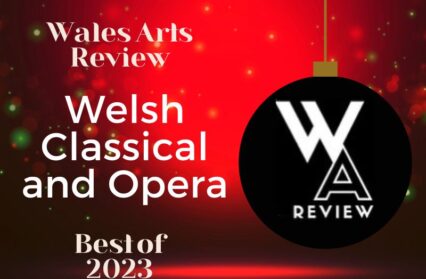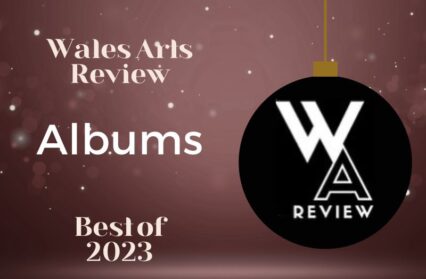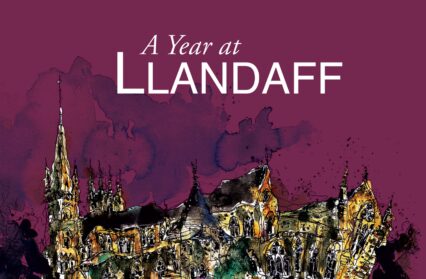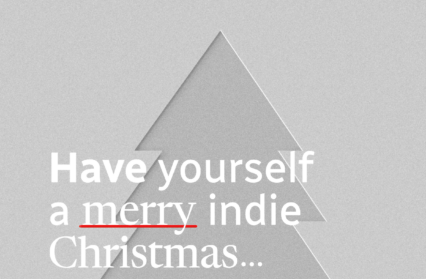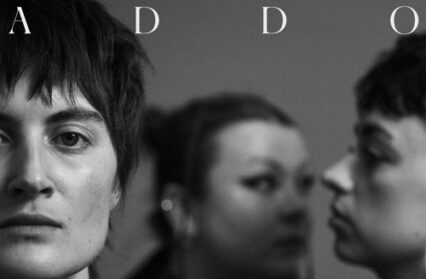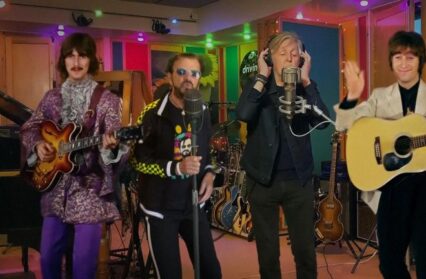The time is here. Now in our tenth week of the series, we finally reveal our top 10-1 in the one hundred greatest Welsh albums of all time. There has been reflection, toil and debate, but we’ve finally whittled down an incredible range of truly brilliant music to just ten records. So drum roll please, taking in Welsh legends old and new, genres spanning indie-rock, hip-hop, baroque pop and much more, here are Wales Arts Review’s Top 10 in the One Hundred Greatest Welsh Albums of All Time series.
10
Gruff Rhys
American Interior
(2014, Turnstile)
It’s the framework provided by telling the life of Rhys’ ancestor, John Evans, that really makes this album reach the heights that it does. It gives Rhys a rare focus, and it pays off. Evans was “an orphaned farm hand… [who] left Wales for Baltimore in 1972 and walked alone with $1.75 to his name into the wilderness of the Allegheny mountains… in search of a lost tribe of Welsh-speaking Native American, believed by some to be the descendants of Prince Madog…” If that sounds like the sort of typically whimsical subject matter that you might expect to find informing a Gruff Rhys concept album then, well, fair enough, but there is a seriousness behind this record that should not be disregarded. In American Interior, Rhys translates his Welsh mountain loneliness to 17th Century mid-America and the results, perhaps most especially as the album draws to a close – and on ‘Walk into the Wilderness’ in particular – are stunning. American Interior was largely recorded in Bright Eyes producer Mike Moggis’ studio in Omaha, Nebraska, and the record has an accordingly alt-America feel to it. But it is also a record that recalls the classic early Super Furry Animals of Fuzzy Logic and Radiator. There surely haven’t been this many classic guitar sounds on a Gruff-led album since 1997. Is the solo on the title track his most straightforward and best, in fact, since ‘Hometown Unicorn’ in 1996? Do the beatific pedal steel-scapes on ‘Tiger’s Tale’ consciously echo Radiator‘s classic ‘Mountain People’? There are also hosts of great pop songs here, like the Love-esque ‘The Whether (Or Not)’ and the Neon Neon-like ‘Lost Tribes’, all of which goes to make this album, which is concerned at heart with forgotten languages, races and customs, one of Rhys’ most commercially accessible records to date. A subversive achievement indeed.
9
Cate Le Bon
Reward
(2019, Mexican Summer)
Le Bon’s genius lies in her ability to mingle poetry and authenticity. She resists stripping back personal numbers with acoustic blandness, and dresses them up to greater effect, instead. Reward is an album moulded by the remoteness of her writing location; the importance of place exists primarily in the quietness of exile, the topography of Le Bon’s mental landscape. The strenuous, physical work of crafting furniture makes for an impassioned introspection, a deep delve into the self. As an artistic tale, the album’s construction is a resonant one. It is untainted by the demand to produce, produce, produce that frequently accompanies an entertainment industry that prizes quantity over quality, speed over precision. Despite serious scope for self-righteousness, Reward – and indeed Le Bon herself – is notably unpretentious. While this kin’s artistic projects can feel equivalent to the gap-yah “finding myself” trips taken by a certain class of rich 20-somethings, Reward has all the marks and feeling of a genuine inner journey. One took not to impress or pursue pseudo-self-development, but because of a genuine drive to know oneself and one’s art.
8
Skindred
Roots Rock Riot
(2007, Bieler Bros)
Perhaps a little too mainstream for some tastes, and arguably without the gangrenous bite of Babylon (2002) or Union Black (2011), it is in fact Roots Rock Riot that displays the titanic features of Skindred at their best. It has all the grizzled rage you’d expect from one of the world’s favourite bands of the heavy rock circuit of their era, all the primal Gods of Olympus stagecraft, but it also has an enormous helping of melodious ideas and turns of riff that wouldn’t go amiss on a pop album. Okay, so accessibility isn’t necessarily a stamp of approval many bands like Skindred are after, but it’s not how easy on the ear this album might be to the masses that’s the point here. The thing that shines on Roots Rock Riot is the meeting point of the band’s influences, and particularly the influences on front-and-centreman Benji Webbe — rock, ska, reggae, grunge. The tension between these forms opens up chasms, and Webbe’s presence, backed by the granite riffs of guitarist “Mikeydemus” Fry, the pulsating bass of Dan Pugsley, and the heavy sweating drums of Arya Goggin. The opening title track is a tour de force, a gripping salvo that sets up some of the glittering intensity that follows. “Trouble” is perhaps a perfect example of the feel of the album — a hard central riff, but flittered over with a dextrous vocal performance from Webbe, and a hook that will make as many want to swing hips as much as mosh. The single “Ratrace” is a totemic statement on the very idea of Skindred. Great art is about ideas, how interesting they are and how arrestingly they are presented; but also how conflicting ones are related, juxtaposed, and what that means to the expressed whole. Roots Rock Riot is an exhausting display of bristling, blooming ideas. As for Webbe, a talent like Wales has never seen before, and perhaps might never see again, this album is his magnum opus. He is a great songwriter, great lyricist, but with it a massive performer of massive moments. And all those things are here. If it feels a little over-produced at times, a little angled toward the American market who by the mid-noughties were lying their rock extremely clean and radio-friendly, it only now gives the music an admirable clarity, a clear vision. Roots Rock Riot is a huge, audacious manifesto of music and philosophy and where the two crossover. It exists in the fault lines of a thousand ideas and influences, and no matter how many times you listen to it, there will never be a dull moment.
7
Irma Vep
Embarrassed Landscape
(2020, Gringo Records)
If the Velvet Underground don’t qualify for this list for being only 1/5 Welsh at best, then Irma Vep’s Embarrassed Landscapes provides the next best thing. John Cale’s old band runs its influence through the gritted teeth and distorted, discordant, refulgent rage of this record like water finding the path of least resistance. But Embarrassed Landscape does what all great albums do that are indebted to iconic forefathers, and it makes something fresh and new whilst holding the familiar aloft like some kind of sacrificial offering to the gods of rock n roll. That’s right, if, as Lou Reed had it, life can be saved by rock n roll, then there is some stuff going on in here that isn’t just life-saving, it’s life-affirming, it’s resurrectional. Irma Vep is Edwin Stevens (and not Maggie Cheung) and Embarrassed Landscapes was recorded, it seems, in a heady state of upheaval and musical nomadacy, moving between makeshift spaces in Glasgow and Llanfairfechan. It seems to have been a ramshackle recording experience, although not a process alien to Stevens. Embarrassed Landscapes is an album that smacks of placelessness, of snatched opportunities, and of a rageful, yearning spirit. There are no bigger opening statements of intent on this list than “King Kong”, a 10-minute alt-rock fugue of feedback, off-tune strings, and a Cry Baby pedal that gets right up into your spinal fluid. But Stevens is also a consummate, original, soulful songwriter. “Disaster” is beautifully sad, and “I Do What I Want” sits quite comfortably with any of the best indy pop singles of the last thirty years. A loving relationship with Embarrassed Landscapes will have you moving from George Harrison to The Monks to Pulp to My Bloody Valentine without ever really feeling you’ve left the caustic, longing vicinity of Irma Vep’s dank but welcoming 1980s monochrome bedsit. It’s an album of consistent conceptual energy, of energising riffs and lyrical turns. Stevens is a life-saver.
6
John Cale
Paris 1919
(1973, Reprise Records)
Musically this might well be Cale’s most accessible achievement. With ‘Macbeth’ being a perfect glam rock stomper and ‘Graham Greene’ almost reaching a reggae skank. A long way from the avant-rock of La Monte Young or even the Velvet’s first album. But, let us not forget that Lou Reed had recently become the dark knight of glam rock due to a friendship forged with an alien rock messiah called Ziggy Stardust, who had been, in turn, heavily influenced by the Reed/Cale line up of the Velvets. The music on this album diversifies so effortlessly between classical, rock, avant-garde and pop that it could be argued that its influence has been felt as equally as any Velvets record, in that it frees the artist to express himself in any way they see fit or can accomplish. But, also, it takes that journey completely seriously and has been copied over the years by much more monetarily successful and completely humourless pop stars. Cale’s album is brimming with humour and intellectualism being aware of one another, with neither being the exclusive drive of the artist. Paris 1919 could be the greatest Welsh rock album ever made because it lives and breathes Wales. Like the Welsh people, it is passionate about all culture, grandiose, sometimes frustrating but always sincere, intellectual and proud but self-aware and full of humour, brave and determined to travel and explore, a pilgrim of our green and pleasant lands. It should be taught in schools. It should be everywhere. What is that look on the man’s face on the album cover? It’s a welcoming face, inviting us to take the journey of lifetimes.
5
Manic Street Preachers
The Holy Bible
(1994, Epic)
The gravelly, strained guitars and curiously Brit-pop drums sit alongside James Dean Bradfield’s stilted lyrical settings (the lyrics themselves being written by Edwards and Wire). The gait of his melodies is still, all these years later, difficult to anticipate and remember. The music feels disjointed, as though it’s not quite fitting together correctly. Musically, too, The Holy Bible is relentlessly uncomfortable; angular riffs, unexpected rhythmic jolts, disgustingly dissonant music popping out of nowhere, and cruelly heavy and raw guitar parts grinding away. The core of the music feels so volatile that it can barely contain itself – there’s a constant state of restraint battling against unexpected progressive rock, metal, punk, and hardcore influences. The guitar solos are grotesquely transformed into something that no longer resembles the 1980s flowerbeds they were picked from. Its dense synthesis of influences makes it almost impossible to parody and only serves to drive home the Manics’ peculiar aesthetic.
The Holy Bible is grossly relevant to all of our lives. The rhetoric regarding wealth, surveillance, the politics of language, the insanity of genocide denial, mental health, physical abuse, and the role of white America in shaping the world is terrifyingly on-point. This album sees the Manics explode a kernel of Welshness into something transcendent, all-encompassing, and desperately reassuring. The Holy Bible isn’t just a great album, it is a towering monument to suffering.
4
Applied Science
We and the Devil
(2021, Mean Business Records)
The Newport hip hop duo comprising of DJ Alkemy and MC Pun-Ra created in 2017 released Wales’s greatest rap album, a bluesy, rock-filled, hard, funny, tripping, crude, soulful journey through the Welsh industrial working class experience. In places, it’s like two smart-mouth kids from a council estate have crashed a Muddy Waters gig. In others it’s like G-Love if G-Love had been from an iron-and-steel city of fist fights and dole queues rather than a beach hut shaded by palm trees. We and the Devil is a remarkable record on many levels, not least for its unrelenting quality of sampling, and what the boys do with those samples. “Get Up” rattles around like you’re getting caught in some crossfire; “Blind Drunk” sounds like they had John Lee Hooker in on the session; “Brash” loops the bass like a wrecking ball going at the theme tune of a 70s cop show; “Looney Tunes” has too much fun with cartoon sound effects than they should be able to get away with; “Holy Moses” sounds like Hank Mobley playing a New Orleans funeral parade; “Brutal Psyche” mixes heavy percussion with Colin Stetson-esque sax riffs. There is, to put it simply, not a moment of We and the Devil that doesn’t dazzle, enthral, and lift the spirit. Lyrically, Alkemy and Pun-Ra don’t mess about. They spit and splutter about the low living of the south Walian working class, but as it should be with great artists, they lift that up into something more important, more sublime, than a simple gripe or a moan at the bar. This is an album of hilariously coarse self-reflection, but also of astute social observation — observation from the inside out. These guys are the real deal — “authentic”, if that label does it for you; but what matters is there is not a second of this long, sprawling album that doesn’t feel real, true, and vital. If you want to know what it’s like to live in these places, this is the album that will let you in — musically and lyrically.
3
Deyah
Care City
(2020, High Mileage, Low Life)
In 2020, Deyah became the first black artist to win the Welsh Music Prize, and there could be no finer winner than Care City. Deyah is clear from the start that Care City is not just a collection of tracks; it’s a state of mind. Although hip-hop has a rich history when it comes to concept albums, the idea of an album being a state of mind, a feeling – rather than narrative-driven as with The Roots’ Undun (2011) or Ghostface Killah’s 36 Seasons (2014) – is something that is rare amongst the abundance of other brilliant concept albums. Care City is about belonging as much as it is about Cardiff or Nigeria. Deyah’s brutally confessional style compels the listener to be invested in her thoughts, emotions and actions. She is a brilliant rapper and she showcases mesmerising flows. Musically too, Deyah has created some intimate spaces. “Planet X” brings more of the spacey atmospherics but this time with added funk to husky vocals, with the strummed guitar adding to the laid-back feel. There is a powerful meeting of music and voice. “Ciao”, the album’s fifth track, is a melancholic reflection on past mistakes. The captivating bassline and drums blend well with the dark lyrical content which covers drug abuse, past relationships and depression. Closing track “Liquor Lament” is undoubtedly a standout moment in which Deyah discusses her internal conflict regarding her increasingly distant relationship with God. She discusses temptation and sin whilst also questioning whether she’s lost her spirituality – and what she must do to regain it. The honesty here is so vivid, so powerfully expressed, it begins to feel as though Deyah is opposite you in a confessional booth. This is no accident; Care City is a spiritual album deeply concerned with faith and religion, and ‘Liquor Lament’ is its climax. The synth-infused R&B instrumentation blends well with the lyrical content and is the perfect outro to a brilliantly brave and personal album.
2
Young Marble Giants
Colossal Youth
(1980, Rough Trade)
The album comes out of nowhere; an ambiguous, modest wheeze of synthesised effects, barely registering; and thirty-eight minutes later it fffts and purrs, a nervously prodded organ seems to disassemble before you, and the album’s over, and you’re left wondering what exactly just happened. Nothing sounds like Colossal Youth. It has its kin – I could list many albums that remind me of it – Nico’s The Marble Index (1969), Skip Spence’s Oar (1969)– but these records don’t sound like Colossal Youth, they merely seem to inhabit the same space; most likely an empty dilapidated old picture house with fallen gantry and ripped up ruby-coloured upholstery. Released by Cardiff trio Young Marble Giants in 1980, Colossal Youth is perhaps the great time (and simultaneously timeless) capsule of the turn of one remarkable decade into the next. What the seventies will be remembered for, musically, is punk, and what the eighties will be remembered for is the electronica of the synthesiser. Where Colossal Youth sits is at this right angle where the three-chord gob of punk and the earnest shoulder swaying of New Romanticism is exactly at its most interesting point. It is a deconstructionist masterpiece, in that it does exactly what Howard Devoto could never really bring himself to do with Magazine, and that is: lay bare.
The music on Colossal Youth would surely have been mistaken for a demo by any other record label execs had YMB not been signed to Rough Trade, where they shared a stable with other creatives who sounded like nobody else (think of The Smiths’ début, Scritti Politti’s ‘Skank Bloc Bologna’ (1978), and Ivor Cutler’s Privilege (1983), and you begin to get an idea of Rough Trade’s philosophy in the early 1980s). That the music sounds so incomplete is only part of the charm. There is much being done in the empty spaces. It is folk music, of course, only the folk of the basement night club with sweat-dripping walls, leather and denim, acne, bubble gum, and monochrome nights where nothing quite goes to plan. Alison Statton’s vocal is pure flat-folk, in the tradition of the fifties’ London coffee dens. There are little inflexion and no passion, and it is captivating, palely sitting atop the intricately assembled songs like a barefoot chanteuse, legs tucked under the bottom, on a Moroccan rug.
And these songs are not composed, not ‘played’ like the Buzzcocks might have recorded them; they are assembled, every inch clicked into place, carefully, but far from delicately. These songs are robust. Anything less sturdy would not have lasted so long, so well. Kurt Cobain took more from the Moxham Brothers’ songs than he ever did from the Sex Pistols, and he readily admitted it.
1
Scritti Politti
Songs to Remember
(1982, Rough Trade)
They say that good things come to those who wait. A maxim that perfectly encapsulates the deferred release of Scritti’s debut album in the September of 1982 – a point in time that bookends the giddy three-year imperial phase of Britain’s post-punk/new pop revolution. Significantly delayed, for initially personal and latterly artistic reasons, Songs to Remember remains the album that best represents that unique period in British music history – when the kids who most understood the true spirit of punk swiftly tossed aside its dreary old rulebook and reached out to grasp pop’s glittering prize.
As a former member of the ‘sensible knitwear’ faction of provincial punk’s avant-garde, Green Gartside – a product of a concrete South Wales new town – emerges here as one of the genre’s most fascinating maverick figures and, to this day, the possessor of one of the finest white soul voices that this nation has ever gifted to the world. Within the grooves of this timeless album, his seemingly effortless vocals weave golden strands of unconventional political thinking into a luxuriously inventive fusion of funk, reggae, soul and jazz. At the time, it represented a jolting wake-up call to many of the band’s early followers, and almost certainly to its record company, Rough Trade, who initially struggled to keep up with the new-found ambition underpinning Gartside’s musical reinvention.
Having abandoned the Marxist ideology of the band’s initial manifesto and recordings, the artist instead turns his attention to French philosophy (Jacques Derrida), the writings of Nietzsche (Asylums in Jerusalem) and the self-flagellating introspective funk of Lions After Slumber. It’s a delicious combination that is unapologetic about its shiny new veneer and which acknowledges, as Gartside himself did, that “you don’t have to be lobotomised in order to make pop music”. Most importantly perhaps, Songs to Remember is an album unshackled from any anxieties about the tedious notion of ‘selling out’ – a hippy notion incongruously co-opted by punk’s most narrow of thinkers. It’s a collection of songs that brushes up without dumbing down and which sprinkles glitter upon asphalt.
It also contains an album closer so heartbreakingly perfect that all others must surely bow down before it. The Sweetest Girl, a song supposedly about “the tendency for things to fall apart in the light of political awareness” – remains one of the finest songs of the 1980s, or of any decade. A honey-drenched exercise in eclectic, self-assured pop magnificence and one that continues to beguile audiences almost four decades later. Recent Scritti live shows have seen Gartside open proceedings with the song in a joyous display of getting your big guns out early – a wholly justified act of self-confidence given the deep well of vocal majesty that he can still draw from.
It’s a move almost as self-assured as calling your debut album Songs to Remember – but who would begrudge Gartside that? This is intellectual art pop in excelsis. An exercise in sublime pop futurism and a masterclass in the art of creative renaissance.
Dive into seven hours of the greatest music to ever come out of Wales with our Greatest Welsh Albums of All Time playlist. Click here.
To find out our picks for 100-91, 90-81, 80-71, 70-61, 60-51. 50-41, 40-31, 30-21, and 20 -11 in the Wales Arts Review 100 Greatest Welsh Albums of All Time just follow the links.
*
List compiled by Wales Arts Review and friends of the Review. Words by Cath Holland, Tilly Foulkes, Caragh Medlicott, John Lavin, Gray Taylor, Nerys Williams, Craig Austin, Jude Rogers, David Roche, James Deacon, Jack Boyce, Gareth Smith, Tomos Williams, and Gary Raymond.





